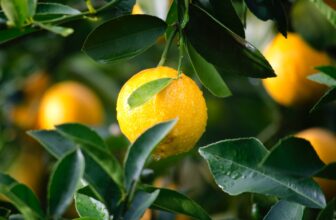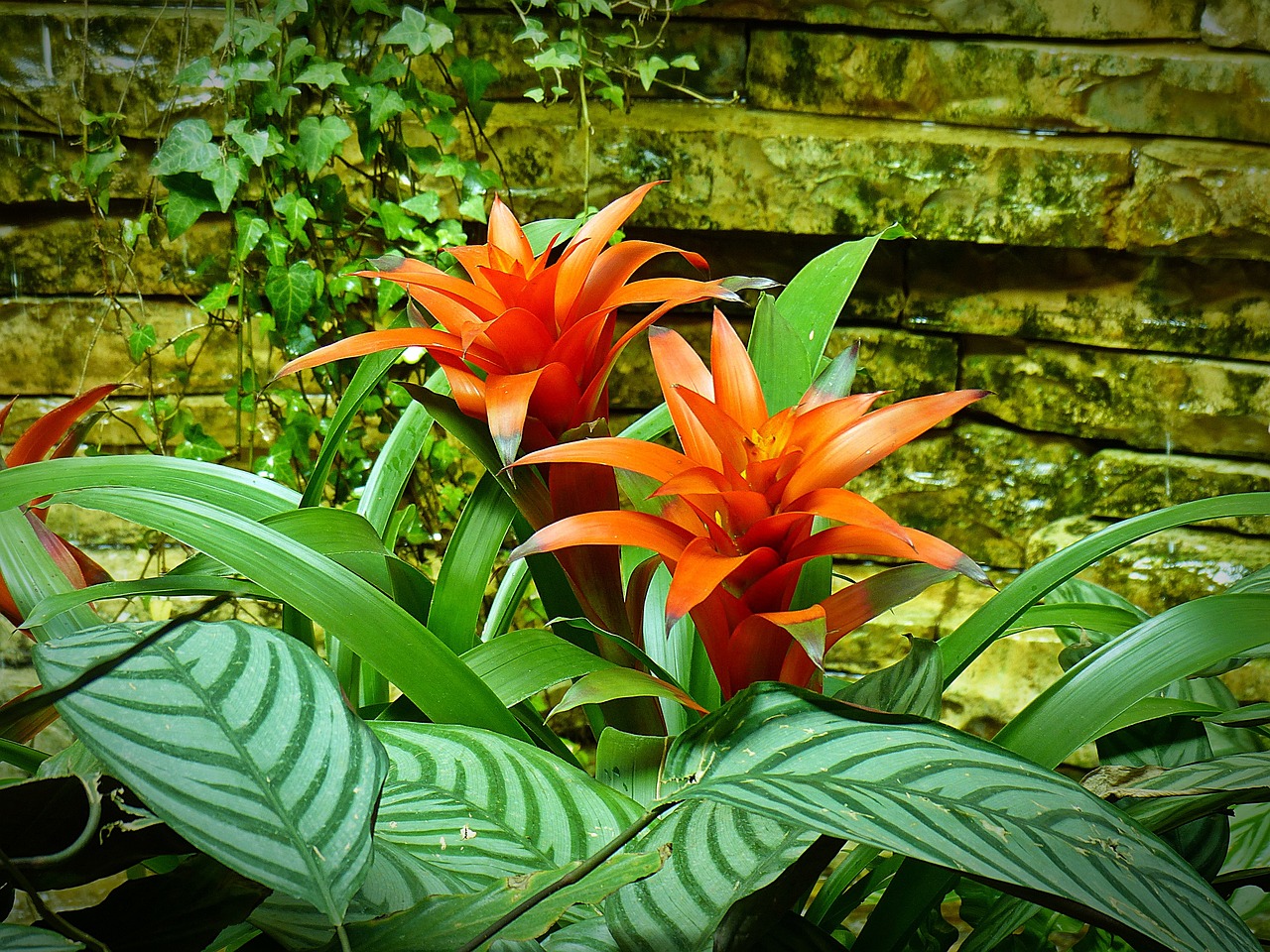
Table of Content
One of the most exotic and tropical-looking plants is the Bromeliad. It is attractive ornamental houseplants that bring a burst of color and texture to your home or interior garden. Bromeliads indoors are easy to grow and require low maintenance. But a major advantage to having this in your home is it helps purify the air. Bromeliads eliminate toxins and release oxygen at night.
Bromeliads are part of the Bromeliaceae plant family. The pineapple species is the most popular out of 3,000 Bromeliad varieties, but others take different shapes and forms. Before the plant reaches the end of its life, it sometimes produces a flower or inflorescence. The different flowers bring a burst of color and character into your indoor setting.
Once you have a bromeliad, you can place them indoors with medium to bright light surroundings. With the proper care, it will thrive in its given living space as a unique houseplant. Some can grow indoors in cooler climates, while other Bromeliad species can survive in freezing temperatures. Here’s a brief look at the different types of Bromeliads.
Urn Plant (Aechmea Fasciata Bromeliad)
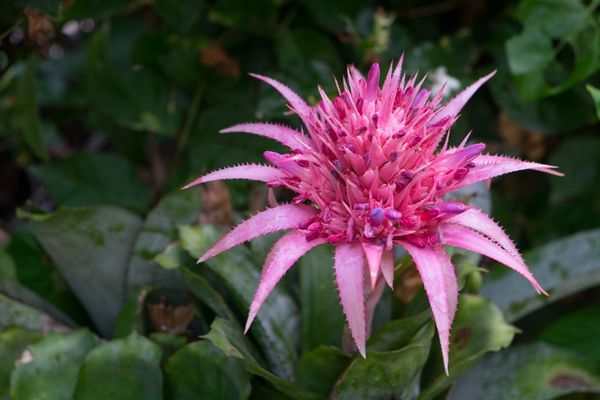
The Urn Plant or the Aechmea’s name in Greek means spear tip. The plant’s rosette has pointed spear-shaped leaves and a spiked flower head in the center when it blooms. It has about 250 flowering species that grow in the Caribbean, Mexico, and South America. This is a slow-growing plant that will grow up to 2 feet tall but is non-toxic to people or pets.
| Care Instructions | Easy and low-maintenance |
| Water Details | The plant’s cup must be filled with frequently changed water to avoid bacterial growth. |
| Feeding Schedule | Water soluble or liquid fertilizer is fed once during the growing period. |
| Light Requirement | Indirect sunlight to partial shade. |
| Temperature & Humidity | Above 55˚F with moderate humidity. |
| Soil | Any soil mix. |
Pineapple Bromeliad (Ananas Comosus)
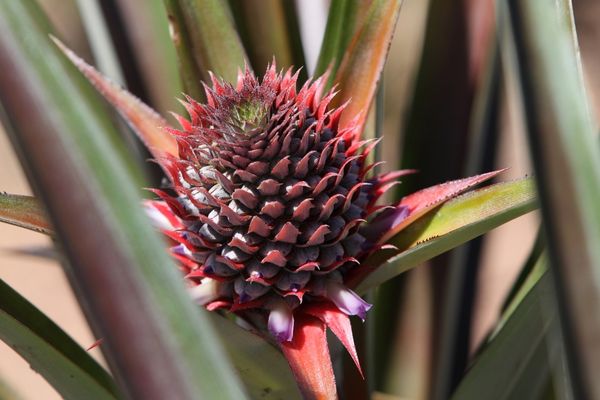
The Pineapple Bromeliad (Ananas Comosus) is globally recognized as an ornamental houseplant and a fruit for eating. It is native to South America and is classified as delicious tropical fruit. The pineapple is the central inflorescence of the rosette of leaves and grows 3-5 feet tall. Immature pineapple is poisonous to pets and people and can be toxic to pets.
| Care Instructions | Low-maintenance but hardly grows in Northern climates. |
| Water Details | Water once a week when the soil is dry to have moist but not soggy soil. |
| Feeding Schedule | Use a balanced fertilizer once every two months, then increase to every two weeks when the fruit has formed. |
| Light Requirement | Bright direct sunlight for eight hours to produce fruit |
| Temperature & Humidity | A temperature of 65˚F- 95˚F with moderate to high humidity. |
| Soil | Well-draining but nutrient-rich soil. |
Queens Tears (Billbergia Bromeliad)
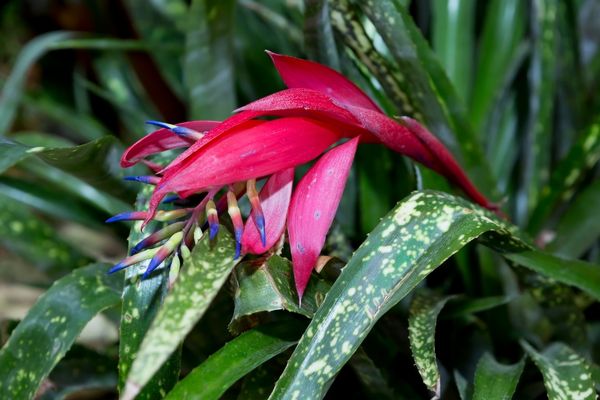
Queen Tears (Billbergia Bromeliad) has 60 species and are classified as epiphytic plants that grow attached to trees at high altitudes. The attractive but short-lived flowers have a variety of colors like blue, purple, yellow, green, or white. Depending on the plant species, its height can reach 8-36 inches and is non-toxic to people or pets.
| Care Instructions | Easy and low-maintenance |
| Water Details | Water only when the soil is dried completely. Use filtered water and keep the pant cup filled. |
| Feeding Schedule | No need to fertilize to avoid over-feeding and allow blossoming. |
| Light Requirement | Indirect Sunlight with bright surroundings. |
| Temperature & Humidity | Ideal Indoor Temperature of 70˚F but can tolerate 26˚F-100˚F. Well-circulated air with high humidity. |
| Soil | Keep soil moist, not soggy. |
Earth Star (Cryptanthus Bromeliad)
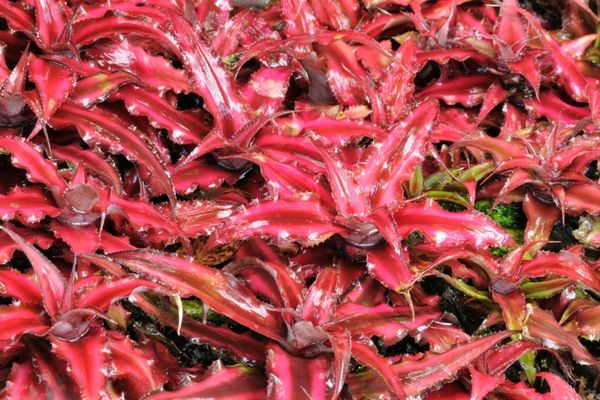
New to the bromeliad family, Earth Star (Cryptanthus Bromeliad) is a terrestrial genus plant native to Brazil. Their foliage appeal makes them stand out and grows well as a potted plant. It has a unique growth with leaves arranged in low but tight rosettes of dark green to bright pink or red.
| Care Instructions | Moderately easy to maintain. |
| Water Details | Avoid excessive watering at low temperatures but use weekly new water in its cup |
| Feeding Schedule | Use regular fertilizer of potting mix with peat moss every three weeks. |
| Light Requirement | Bright but filtered light or partially shaded area. |
| Temperature & Humidity | Humid Environment with a room temperature of 60˚-85˚F |
| Soil | A damp soil that retains water. |
Pale Ryder (Dyckia Bromeliad)
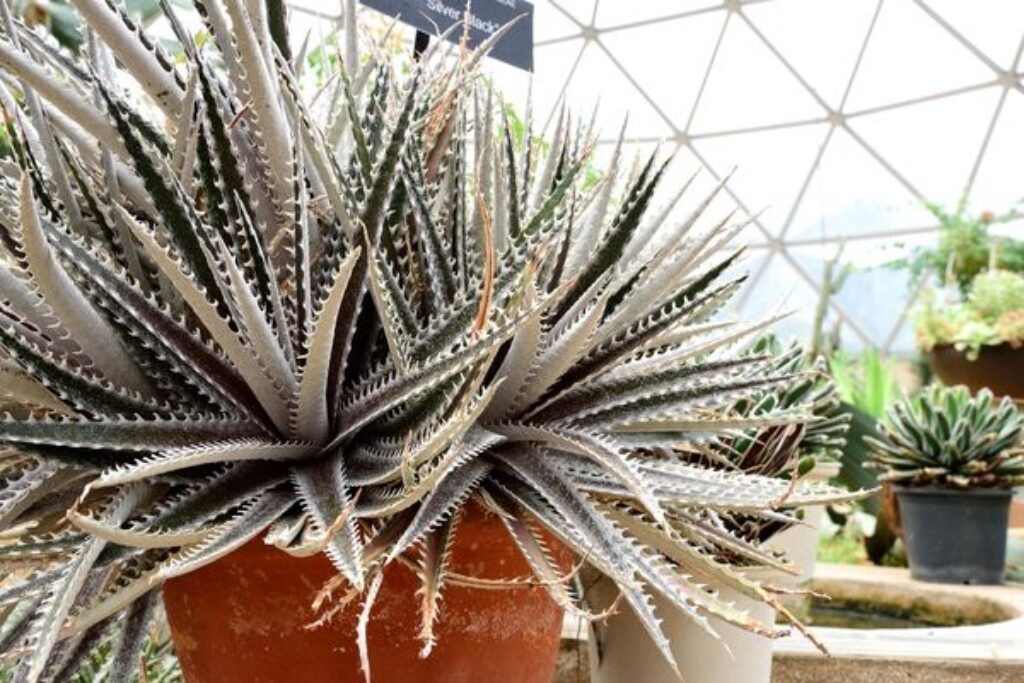
A favorite house plant and xeriscaping, the Pale Ryder ( Dyckia Bromeliad) is a terrestrial plant but grows well potted. It resembles a small octopus with sharply pointed or tentacle-like leaves arranged in rosettes. Their colors vary from green, yellow, gray, or red. They grow 8 inches tall and several feet wide but are non-toxic to people or pets.
| Care Instructions | Fairly low-maintenance |
| Water Details | The plant’s cup must be filled with frequently changed water to avoid bacterial growth. |
| Feeding Schedule | No need to fertilize. |
| Light Requirement | Full sunlight |
| Temperature & Humidity | Moderate humidity of 70˚F- 90˚F |
| Soil | A well-draining potting mix for succulents. The soil must be moist during summer and spring. Less water for fall and winter. |
Scarlet Star (Guzmania Lingulata)
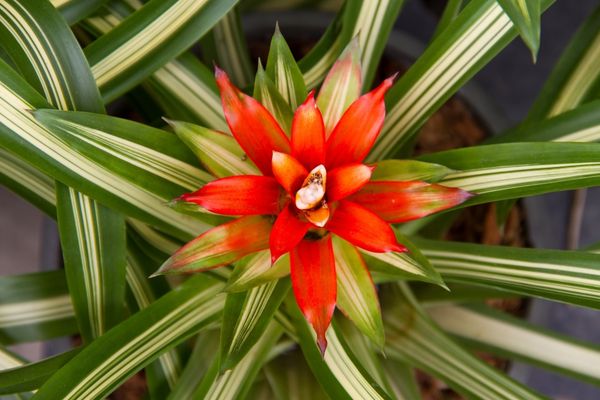
The Scarlet Star (Guzmania lingulata) is a common house plant that is a native of Middle and South America. It can grow attached to a host plant or in regular potting soil. Its roots grow above the soil and take three to four years to mature with a height of 18-24 inches that is non-toxic. The flower looks like a cup-like star of deep scarlet or orange with tiny white flowers inside the head.
| Care Instructions | Moderate maintenance |
| Water Details | The roots must be misted daily. The cup of the flow must be filled with new distilled water every four days. |
| Feeding Schedule | Use a half-strength fertilizer mix without touching the root system. |
| Light Requirement | Indirect sunlight with bright surroundings. |
| Temperature & Humidity | Average room temperature of 65˚-80˚F |
| Soil | Wet soil but not soggy then allow to completely dry before watering again. |
Silver Star (Hechtia Genus)
The Silver Star (Hechtia Genus) is a terrestrial Bromeliad with lance-shaped thick and spiny leaves on a central rosette. It originates from regions and is found in Florida, Brazil, and Mexico with only 50 of the Huamelula species of its kind. Hechtia can survive in both extremely hot and extremely cold temperatures. A favorite plant for landscaping, it grows 18-inches in diameter and is non-toxic to people and pets.
| Care Instructions | Low-maintenance with Monitored Moisture |
| Water Details | Water regularly when soil is dry during spring and summer, and reduce during the fall and winter. |
| Feeding Schedule | Use succulent fertilizer to feed once during Spring for growth. |
| Light Requirement | Full sunlight will promote growth but it can survive on the partial shade. |
| Temperature & Humidity | Average indoor temperature with moderate humidity. |
| Soil | Use sandy soil and drained well. |
Blushing Bromeliad (Neoregelia Carolinae Bromeliad)
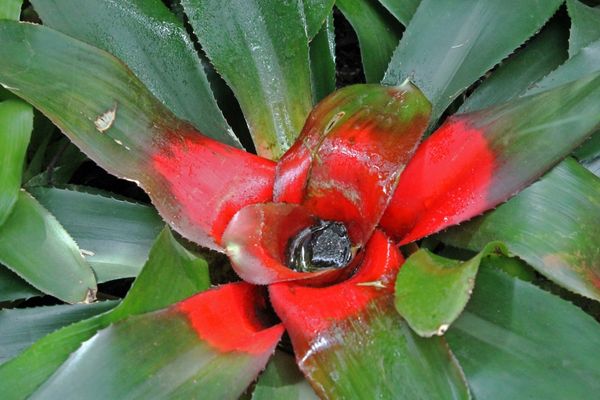
The Blushing Bromeliad (Neoregelia Carolinae) is a favorite houseplant that has several species and hybrids. Its dark pinkish-red center grows within the rosette of narrow variegated leaves. This Bromeliad species measures 12 inches which are shorter without tall flowering bracts but produces beautiful foliage that lasts for months at a time.
| Care Instructions | Easy and low-maintenance |
| Water Details | The plant’s cup must be filled with frequently changed water to avoid bacterial growth. |
| Feeding Schedule | Add a highly diluted liquid fertilizer to the central cup once a month. |
| Light Requirement | Indirect, Partially shaded filtered light |
| Temperature & Humidity | Prefers cold temperature of 55˚ or higher with moderate to high humidity. |
| Soil | Use supportive mixtures that drain without holding moisture. |
Bird’s Nest (Nidularium Bromeliad)
The Bird’s Nest (Nidularium) comes from the Latin word little nest and describes the central inflorescence that sits in the center of the green foliage. It is one of the easiest plants to grow indoors with no fuss. It grows slowly with its mature height of 50 inches and is non-toxic to pets or people.
| Care Instructions | Easy to grow |
| Water Details | Use filtered or soft water a week during summer then reduce it during the winter to avoid moist soil. |
| Feeding Schedule | Water Soluble diluted fertilizer to the central cup once a month during Spring and Summer only. |
| Light Requirement | Bright, Indirect Sunlight |
| Temperature & Humidity | A temperature of 65˚F- 80˚F with a humidity of 60%-70% |
| Soil | A well-drained fertile soil. |
Candy Bromeliad (Portea Bromeliad)
The Candy Bromeliad (Portea Bromeliad) grows on rocks in its natural habitat. It has nine species and is native to Brazil’s Atlantic Coast and is considered a fire retardant. It has a strong light green color protected by sharp spines, with a lengthy inflorescence. The Candy produces a tall coral bloom spike with purple flowers that make it stand out in a landscape or corner of the house.
| Care Instructions | Low-maintenance |
| Water Details | Water when the top is 2-inches dry. This plant is drought tolerant. |
| Feeding Schedule | Water soluble fertilizer is given once a year. |
| Light Requirement | Full sunlight |
| Temperature & Humidity | It can survive winter temperatures of 30˚F but is frost sensitive. Humidity is 60%. |
| Soil | A well-draining and porous container with a rich potting mix |
Medusa’s Head (Tillandsia Bromeliad)
Medusa’s Head (Tillandsia Bromeliad) has 500 species of its kind, with some being terrestrial while others are saxicolous. They are native to Southern America and the Southern United States. The flowers are tubular and have attractive shades of violet, pink, blue, yellow, white, pink, etc.
| Care Instructions | Easy to grow and very low-maintenance |
| Water Details | Mist the plant once or twice a week during summer and once a month during winter. |
| Feeding Schedule | Use Bromeliad or Orchid fertilizer mixed in the misting water once during spring. |
| Light Requirement | Bright filtered sunlight |
| Temperature & Humidity | Moderate humidity and average indoor temperature. |
| Soil | No soil is needed. |
Flaming Sword (Vriesea Splendens Bromeliad)
The Flaming Sword (Vriesea Splendens) is native to the subtropical parts of North, Central, and South America. It is considered a foliage and flowering plant that has vibrant sword-shaped inflorescence spikes with feathery variegated leaves. It has no roots but has special anchors called holdfasts that make them hold onto trees.
| Care Instructions | Easy and low-maintenance |
| Water Details | Use filtered or soft water to fill the central cup but change to new water to avoid bacterial growth. |
| Feeding Schedule | Add a water-soluble fertilizer to the central cup once a month during spring and summer |
| Light Requirement | Bright indirect sunlight |
| Temperature & Humidity | Temperature of 60˚F- 80˚F with 50% humidity. |
| Soil | A potting mixture of half soil and half perlite or bark. |
Wrapping Up
Plants, particularly Bromeliads have a unique decorative touch to an indoor space. While there are many Bromeliad varieties, not all can grow in a partially shaded area.
The list above offers you a choice of what may fit the character of your home or what you can add to your indoor landscape. Get one or two of the Bromeliads and see how it enhances your indoor home.






